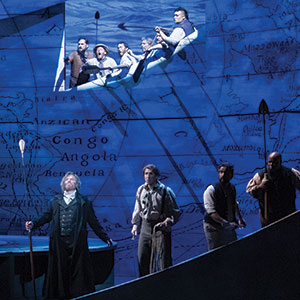Features & Columns
Silicon Alleys: 'Moby-Dick' Gets Operatic Treatment at SJICA
 Opera San Jose debuts its version of 'Moby-Dick' at the San Jose Institute of Contemporary Art. Photo by Dana Sohm
Opera San Jose debuts its version of 'Moby-Dick' at the San Jose Institute of Contemporary Art. Photo by Dana SohmThis week, you can call me Ishmael. When I walked into the San Jose Institute of Contemporary Art (SJICA) for Opera San Jose's preview of Moby-Dick, I felt like the existential outcast narrator of that book, or maybe even Queequeg, compared to the genteel opera fans who jam-packed the gallery for the presentation.
Many of them had never before entered SJICA, while, at the same time, some of the gallery folk did not even know composer Jake Heggie and librettist Gene Scheer had written an opera after Moby-Dick. Opera San Jose's version sets sail this weekend at the California Theatre.
A successful cross-pollination of demographics thus joined together for the event at SJICA. Everyone at least seemed to learn something new. This made sense because showing at SJICA through last week, and one reason for the collaboration, was Diane Samuels' exhibit, "It's a Long Story," featuring a series of larger-than-life drawings in which Samuels painstakingly and meticulously hand-wrote the text of a book in micro-size lettering on archival paper. The centerpiece of the exhibition featured the entire text (cough) of Moby-Dick on recycled paper collaged with images pertaining to the novel. The whole draped down the wall and unfurled across the floor, totaling 47 feet long by eight feet wide.
For the opera preview in the neighboring room, Moby-Dick cast members Noah Stewart, Justin Ryan and Richard Cox took the floor, each one belting it to the rafters while Victoria Lington accompanied them on piano. All of which left the genteel crowd agog.
Then Moby-Dick stage director Kristine McIntyre sauntered up and gave a rousing lecture about the novel and the challenges in bringing such a larger-than-life story to the stage. She's read Moby-Dick eight times, most recently over the holiday break, she said.
In the book, Melville repeatedly described Captain Ahab as a monomaniac, using that word 13 times, McIntyre said. He was obsessed with the chase.
"But it's not just a big whale tale," she said. "The book is about friendship. It's a young man's coming of age story." The tattooed cannibal Queequeg is a proto-Yoda figure, a seasoned Jedi Master type of character, said McIntyre. He teaches Ishmael many things about life.
McIntyre said whaling at the time of Melville's novel included a diverse range of people. It was the most democratic job in the 19th century. One could hail from anywhere. Many people from many different backgrounds were found in the whaling business. No sense of otherness existed.
Unlike the novel in which the narrator relates the story in retrospect, the opera unfolds in real time, with Ishmael renamed Greenhorn. McIntyre calls him "a morbid millennial wandering around without a purpose," as if that were a bad thing. And in the opera, tenor Richard Cox portrays Ahab peg-leg and all, a very difficult task for a tenor, or anyone for that matter. He even has to navigate a staircase.
After the SJICA presentation, the genteel audience dispersed throughout the gallery, with many discovering Diane Samuels' work for the first time. People got up close and personal with the sprawling text of Moby-Dick as it filled the room. They snapped images of the micro-text on their phones just so they could zoom in on the resulting imagery, a fantastic way to understand and experience the story's larger-than-life nature.
One of the greatest, if not the greatest American novel ever written, Moby-Dick portrayed the whaling life of "mongrel renegades, and castaways"--my kind of people. As I now declare in retrospect, when I walked into SJICA last week for the opera preview and everyone diligently studying Samuels' work, I felt like Ishmael early in the book when he entered the Spouter Inn and discovered a besmoked old whale painting on the wall, foreshadowing his upcoming adventure. "A boggy, soggy, squitchy picture" it was, "truly, enough to drive a nervous man distracted. Yet was there a sort of indefinite, half-attained, unimaginable sublimity about it that fairly froze you to it."
But no more of this blubbering now. Opera San Jose will go a-whaling at the California Theatre, and there's plenty of that yet to come.


